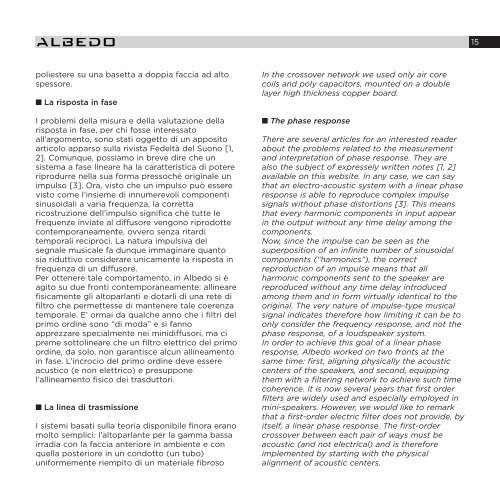scarica pdf - Albedo Audio
scarica pdf - Albedo Audio
scarica pdf - Albedo Audio
Create successful ePaper yourself
Turn your PDF publications into a flip-book with our unique Google optimized e-Paper software.
poliestere su una basetta a doppia faccia ad alto<br />
spessore.<br />
■ La risposta in fase<br />
I problemi della misura e della valutazione della<br />
risposta in fase, per chi fosse interessato<br />
all’argomento, sono stati oggetto di un apposito<br />
articolo apparso sulla rivista Fedeltà del Suono [1,<br />
2]. Comunque, possiamo in breve dire che un<br />
sistema a fase lineare ha la caratteristica di potere<br />
riprodurre nella sua forma pressoché originale un<br />
impulso [3]. Ora, visto che un impulso può essere<br />
visto come l’insieme di innumerevoli componenti<br />
sinusoidali a varia frequenza, la corretta<br />
ricostruzione dell’impulso significa che tutte le<br />
frequenze inviate al diffusore vengono riprodotte<br />
contemporaneamente, ovvero senza ritardi<br />
temporali reciproci. La natura impulsiva del<br />
segnale musicale fa dunque immaginare quanto<br />
sia riduttivo considerare unicamente la risposta in<br />
frequenza di un diffusore.<br />
Per ottenere tale comportamento, in <strong>Albedo</strong> si è<br />
agito su due fronti contemporaneamente: allineare<br />
fisicamente gli altoparlanti e dotarli di una rete di<br />
filtro che permettesse di mantenere tale coerenza<br />
temporale. E’ ormai da qualche anno che i filtri del<br />
primo ordine sono “di moda” e si fanno<br />
apprezzare specialmente nei minidiffusori, ma ci<br />
preme sottolineare che un filtro elettrico del primo<br />
ordine, da solo, non garantisce alcun allineamento<br />
in fase. L’incrocio del primo ordine deve essere<br />
acustico (e non elettrico) e presuppone<br />
l’allineamento fisico dei trasduttori.<br />
■ La linea di trasmissione<br />
I sistemi basati sulla teoria disponibile finora erano<br />
molto semplici: l’altoparlante per la gamma bassa<br />
irradia con la faccia anteriore in ambiente e con<br />
quella posteriore in un condotto (un tubo)<br />
uniformemente riempito di un materiale fibroso<br />
In the crossover network we used only air core<br />
coils and poly capacitors, mounted on a double<br />
layer high thickness copper board.<br />
■ The phase response<br />
There are several articles for an interested reader<br />
about the problems related to the measurement<br />
and interpretation of phase response. They are<br />
also the subject of expressely written notes [1, 2]<br />
available on this website. In any case, we can say<br />
that an electro-acoustic system with a linear phase<br />
response is able to reproduce complex impulse<br />
signals without phase distortions [3]. This means<br />
that every harmonic components in input appear<br />
in the output without any time delay among the<br />
components.<br />
Now, since the impulse can be seen as the<br />
superposition of an infinite number of sinusoidal<br />
components (“harmonics”), the correct<br />
reproduction of an impulse means that all<br />
harmonic components sent to the speaker are<br />
reproduced without any time delay introduced<br />
among them and in form virtually identical to the<br />
original. The very nature of impulse-type musical<br />
signal indicates therefore how limiting it can be to<br />
only consider the frequency response, and not the<br />
phase response, of a loudspeaker system.<br />
In order to achieve this goal of a linear phase<br />
response, <strong>Albedo</strong> worked on two fronts at the<br />
same time: first, aligning physically the acoustic<br />
centers of the speakers, and second, equipping<br />
them with a filtering network to achieve such time<br />
coherence. It is now several years that first order<br />
filters are widely used and especially employed in<br />
mini-speakers. However, we would like to remark<br />
that a first-order electric filter does not provide, by<br />
itself, a linear phase response. The first-order<br />
crossover between each pair of ways must be<br />
acoustic (and not electrical) and is therefore<br />
implemented by starting with the physical<br />
alignment of acoustic centers.<br />
15


